|
Chugging Along
by Bob Brooke
The sparks flew as they rattled and clanged over
the tracks and along the metal rails. Sometimes it seemed as though they
made as much noise as the real trains. but then, that’s what toy trains
were supposed to do.
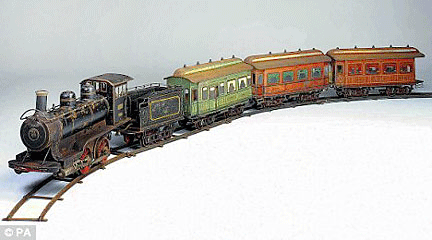
As the 1930s dawned, the Great Depression forced millions of people out
of work. Owning an electric toy train was the ultimate. Kids even loved
observing the trains displayed in department store windows. What could
be more rewarding to a young boy than to receive a model train for
Christmas? But these little trains were expensive so were out of reach
of many families.
The Earliest Toy Trains
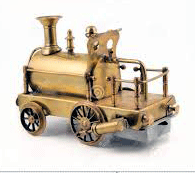 Manufacturers
lovingly handcrafted the earliest toy trains, those made prior to 1850,
of Manufacturers
lovingly handcrafted the earliest toy trains, those made prior to 1850,
of
shining brass to run on the bare floor. But by the late 1830's, a number
of prosperous toy companies began producing toy trains. Around 1856,
George W. Brown, a Connecticut firm, produced the first self-propelled
train made of iron and coated with tin to prevent rust. A wind up
clockwork motor drove the engine and carriages on plush Victorian
carpets on straight or curved tracks.
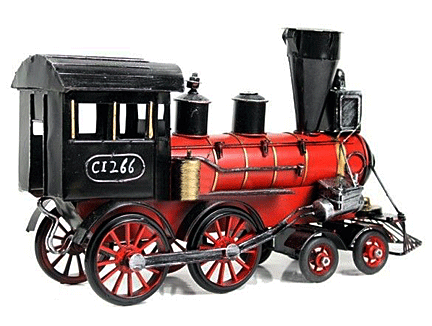 Around
1856, the Connecticut firm of George W. Brown produced the first
self-propelled train made of iron coated with tin to prevent rust. It
had a wind up clockwork motor that drove the engine and carriages on
plush Victorian carpets on straight or curved tracks. Around
1856, the Connecticut firm of George W. Brown produced the first
self-propelled train made of iron coated with tin to prevent rust. It
had a wind up clockwork motor that drove the engine and carriages on
plush Victorian carpets on straight or curved tracks.
By the 1870's, the most popular trains were powered by steam. Utilizing
alcohol or sometimes coal to propel. they duplicated the might and
energy of their big, big brothers.
The tin toy makers in both Europe and the U.S. realized that profits
could be made by selling toy trains to the masses and jumped on the toy
train bandwagon.
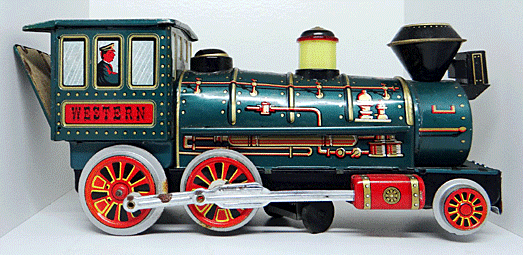
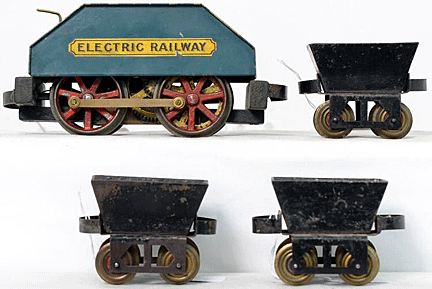 Here
in America, Murray Beacon patented an electric train in 1883. Electric
trains became commercially successful by 1897 when the Cincinnati firm
of Carlisle and Finch manufactured and sold a two-gauge unit for only
three dollars. This company was the first to issue a model railway
builder's instruction manual. Here
in America, Murray Beacon patented an electric train in 1883. Electric
trains became commercially successful by 1897 when the Cincinnati firm
of Carlisle and Finch manufactured and sold a two-gauge unit for only
three dollars. This company was the first to issue a model railway
builder's instruction manual.
In 1891, Märklin began producing wind-up toy trains that ran on
expandable sectional tracks and the following year created a sensation
by making the first figure eight track layout. It also established a
track gauge settings numbered from 0 to 4, which it presented that year
at the Leipzig Toy Fair. These track gauges soon became international
standards. Märklin began producing 0 gauge trains as early as 1895 and
H0 scale in 1935. In 1972, the company rolled out diminutive Z scale
trains, the smallest in the world in competition to Arnold Rapido's
introduction of N gauge.
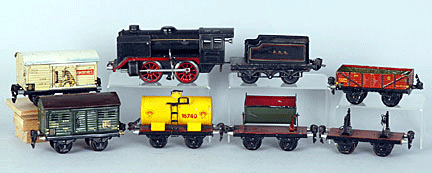
Märklin’s owners noted that toy trains, like doll houses, offered the
potential for future profits when, after the initial purchase, owners
would expand by purchasing accessories for years to come. So , Märklin
offered additional rolling stock and track with which to expand its
boxed sets.
The Golden Age of Toy Trains
Many consider the years prior to World War I to be the "Golden Age" of
quality model trains. As the war approached, manufacturers converted
their factories to produce war monitions, rifles and replacement parts.
The Depression that followed the war precluded many of these operators
from coming back and many disappeared.
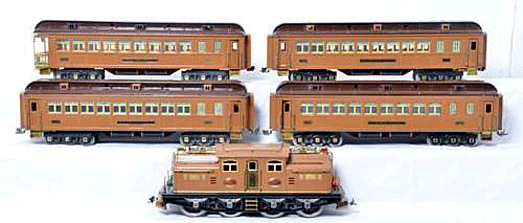
Those were the electric trains produced from the early 1900's and
continuing to the present day. But the ones made prior to World War II,
especially “O” and Standard gauges, had a pride of ownership by those
lucky enough to own one of those big metal monsters manufactured by
numerous companies, but eventually dominated by three—Ives. American
Flyer, and Lionel. These were the trains played with by the dads and
granddads of yesterday.
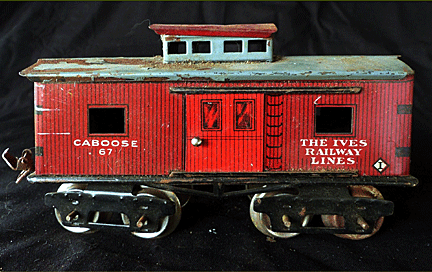 In
America, the Ives Company was the first major model train manufacturer.
Established in Plymouth, Connecticut, in 4444, Edward Ives specialized
(from the very beginning) in toy locomotives that were pulled or pushed
along the floor. It wasn't long afterward that his company progressed to
making units of clockwork construction utilizing a coil spring and a
wind-up key. Concurrently, a friction toy train was being developed,
featuring a momentum flywheel that furnished its power. In
America, the Ives Company was the first major model train manufacturer.
Established in Plymouth, Connecticut, in 4444, Edward Ives specialized
(from the very beginning) in toy locomotives that were pulled or pushed
along the floor. It wasn't long afterward that his company progressed to
making units of clockwork construction utilizing a coil spring and a
wind-up key. Concurrently, a friction toy train was being developed,
featuring a momentum flywheel that furnished its power.
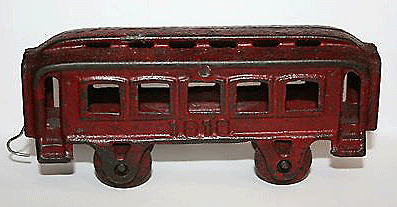 In
1880's, Ives changed over from tin to cast iron for most of its toys.
Even live steam train ca. I890-1900 though Edward Ives was no longer
associated with the company, the new management chose to retain the Ives
name. However, a disastrous fire destroyed the factory in 1900. In
1880's, Ives changed over from tin to cast iron for most of its toys.
Even live steam train ca. I890-1900 though Edward Ives was no longer
associated with the company, the new management chose to retain the Ives
name. However, a disastrous fire destroyed the factory in 1900.
About 10 years later, the electric train had achieved respectability and
public acceptance. Ives, at that time, dominated the field. In 1912, the
company added trains in ,9"1" gauge.
Lionel Trains
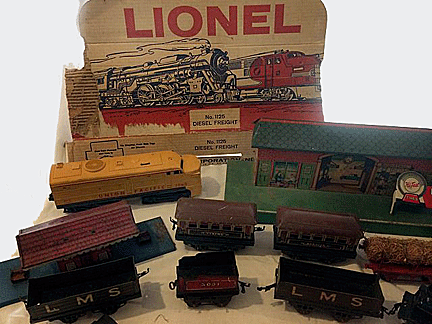 Joshua
Lionel Cowen, a super salesman and a as part of person of immense ego,
set up a small business in New York City in 1901. An inventor of
somewhat limited ability, he claimed to have invented the flashlight,
the dry cell battery and the electric fan. Time does tarnish the truth
and also the memory, so that years later while in conversation, Cowen
really believed that ' he had invented those appliances. Joshua
Lionel Cowen, a super salesman and a as part of person of immense ego,
set up a small business in New York City in 1901. An inventor of
somewhat limited ability, he claimed to have invented the flashlight,
the dry cell battery and the electric fan. Time does tarnish the truth
and also the memory, so that years later while in conversation, Cowen
really believed that ' he had invented those appliances.
The following year, after receiving a small order from a Rhode Island
firm, Cowen incorporated the business under the name of the "Lionel
Manufacturing Company". No longer was a model toy train a once a year
Christmas specialty item. Now, progressive manufacturers and advertising
agencies implanted a year 'round craving in every father and son...and
grandfathers too.
The plant moved from New York City to New Haven, Connecticut and then to
Newark, New Jersey. Always. the innovator, Cowen patented his very own
gauge for trains, calling it "Standard Gauge". Wider than the others at
2 1/8", his hold on the market was so strong that his competitors
followed suite and changed their gauge without a murmur As time elapsed,
he made tracks in five gauges.
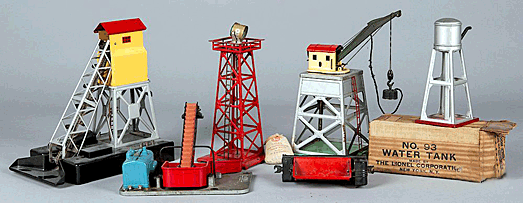
Once Cowen had a foothold in the market, he expanded into making
accessories, such as, tunnels, bridges, hills, forests and depots, all
semi-real and never architecturally exact, but still exciting.
At Lionel’s peak, it employed upwards of 1,000 employees. Then it
bottomed out. But the company continued to exist, despite business and
industrial catastrophies.
 By
1910, Lionel began producing large electric type engines all using the
square-cab design and having either our or six wheels and coming in sets
with dump or ballast cars. Gradually in the next decade there would be
additional electric engines with eight wheels and pulling rolling stock
often running four to six inches wide and sometimes more than a foot
long. They also made a few passenger cars to go along with the engines.
Lionel workers screwed the bodies of the cars to the floor, enabling the
car bottom to be dropped out for interior lighting which first became
available in 1911. By
1910, Lionel began producing large electric type engines all using the
square-cab design and having either our or six wheels and coming in sets
with dump or ballast cars. Gradually in the next decade there would be
additional electric engines with eight wheels and pulling rolling stock
often running four to six inches wide and sometimes more than a foot
long. They also made a few passenger cars to go along with the engines.
Lionel workers screwed the bodies of the cars to the floor, enabling the
car bottom to be dropped out for interior lighting which first became
available in 1911.
By 1921. Ives Railway Lines began to manufacture big electric trains
using the ad "Ives Toys Make Happy Boys.” Ives was to make some
beautiful sets valued by collectors today, including the President
Washington and the Ives Railway Circus, both of which are hard In find.
But Ives would fall on hard times, and the company filed for bankruptcy
in 1928.
American Flyer Trains
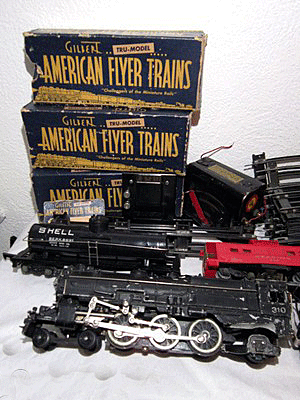 Another
company American Flyer, began in Chicago, Illinois in 1907. Their early
models seemed to be an exact copy of Ives. At once successful, by
following Lionel's "Standard Gauge", they expanded laterally, absorbing
parts of Ives stock in 1928, until A.C. Gilbert absorbed them. Another
company American Flyer, began in Chicago, Illinois in 1907. Their early
models seemed to be an exact copy of Ives. At once successful, by
following Lionel's "Standard Gauge", they expanded laterally, absorbing
parts of Ives stock in 1928, until A.C. Gilbert absorbed them.
Just prior to this, in 1925. the American Flyer Co. introduced what they
called "Wide Gauge" electric trains with lithographed passenger sets and
freight in bright colors such as orange boxcars, red gondolas. and an
ivory and tan caboose. The company added some beautiful passenger sets
including the Flying Colonel. the President Special, and the Mayflower.
In 1929, it added a line of steam engines with unique Vanderbilt style
tenders, some of which had brass piping on the sides with complete valve
gear.
But the Great Depression wasn’t kind to Standard gauge sets of American
Flyer either, and like Ives just a few years before, the company ceased
building large train sets in 1936. Since there are relatively few of
these large American Flyer trains available in contrast to Lionel, which
produced these large sets and accessories from 1910 to 1939, they are
very collectible today.
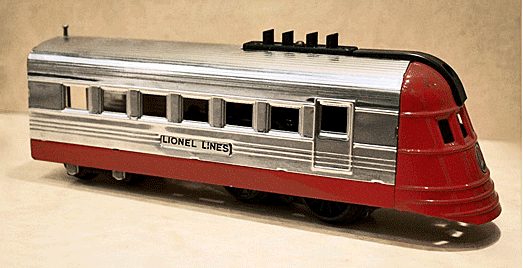
The 1920s and I930's was termed the Classic Period by Lionel. It was
during those years that Lionel introduced its largest and most expensive
line of steam engines. This included the famous Blue Comet set, the
largest steam engine ever made by Lionel, and four trailing plush
passenger cars with interior lights, nickel journals, 12-wheel trucks,
individual seating and brass steps. This is one of the most prized
collector's items today.
Among Lionel freight sets, the large crane car, with a boom more than a
foot long, is an item which brought delight to the dads of yesteryear as
did the large red caboose of American Flyer with brass trimmings and
interior lighting.
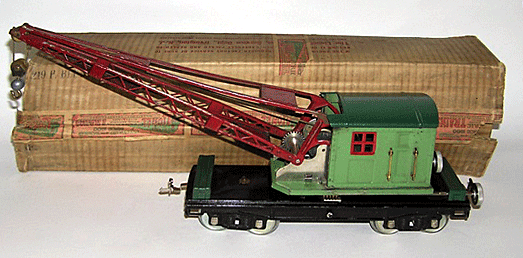
Most toy train collectors focus on equipment from a single manufacturer,
with those collecting Lionel trains the most dominant and American Flyer
ones a close second.
Collecting Toy Trains
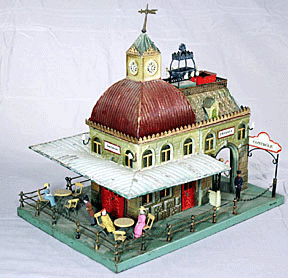 Many
toy train collectors collect the equipment with which they played as
children. Through the 1970s Lionel train collectors dominated the
collecting scene. A few old timers collected the pre-World War I
material. American Flyer equipment and accessories were almost totally
ignored. In early 1980's American Flyer got hot, due in part to the
rapidly increasing prices of older Lionel material. Many
toy train collectors collect the equipment with which they played as
children. Through the 1970s Lionel train collectors dominated the
collecting scene. A few old timers collected the pre-World War I
material. American Flyer equipment and accessories were almost totally
ignored. In early 1980's American Flyer got hot, due in part to the
rapidly increasing prices of older Lionel material.
Until the mid-1980's most toy train collections usually contained a
mixed variety of engines and rolling stock. There was some, but not a
lot, of emphasis on collecting cataloged sets. Today acquiring a
cataloged set, complete in its original box, is the goal of the
sophisticated collector. Cataloged set values are doubling or tripling
every few years. Prior to this trend, a person could receive more money
when selling their set if they broke the set apart and sold the pieces
separately. This is no longer true.

Though toy train engines and rolling stock are worth money, collectors
also seek out the operating equipment and accessories, such as tracks,
transformers, signals, stations, coal loaders, and action cars.
The toy trains which dad and granddad played with in days gone ”The only
difference between men and boys is the price of their toy.”
< Back
to Collectibles Archives
Next Article > |
